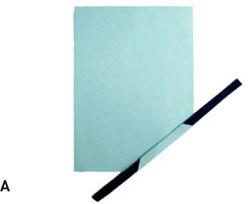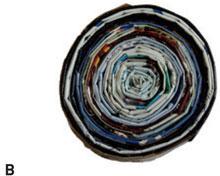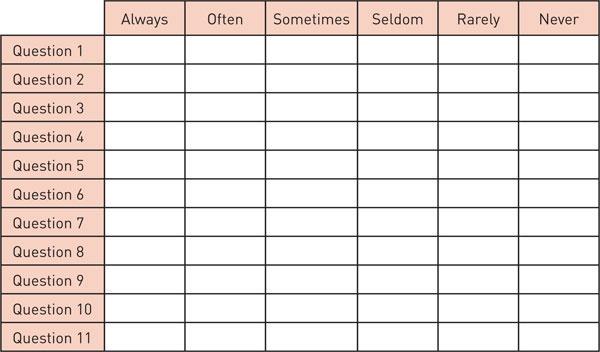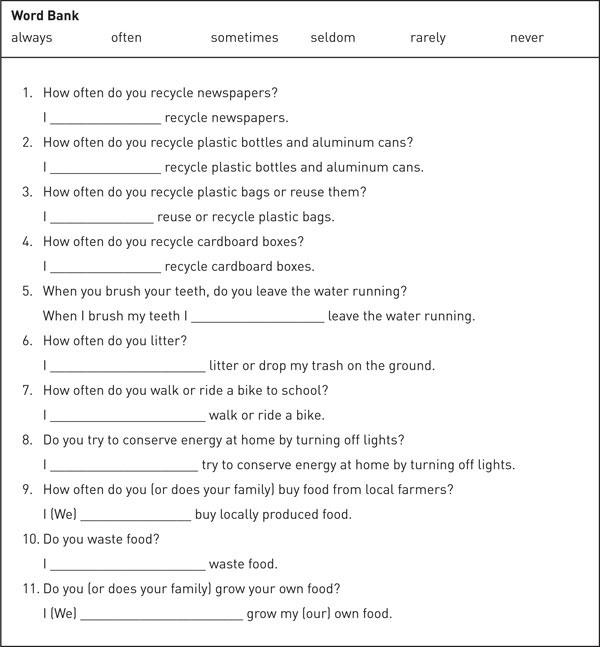Create To Communicate
LESSON 6
OBJECTS
Reduce, Reuse, Recycle
Objective: Students will create a recycled magazine bowl and then conduct an interview using adverbs of frequency.
Level: Beginner to Intermediate
Materials: Old magazines, cardboard sticks one inch wide by twelve inches long, clear tape, and glue.
Teacher Preparation: 1. Collect cardboard and old magazines to use for this activity. 2. Cut cardboard into sticks one inch wide by twelve inches long. Cut enough so that each student has a stick. 3. (Optional) Make a magazine bowl to show students as an example.
Art Options: If magazines are not available, this activity can be modified by having students draw or paint posters about reducing, reusing, or recycling. The posters can outline steps to recycling plastic or metal, offer suggestions on how to reuse certain goods, or generate ideas for reducing waste and consumption.
INSTRUCTIONS
Part One: Reduce, Reuse, Recycle Warm-Up Activity
- Introduce or review these words: reduce, reuse, and recycle with students. Reduce means to make something smaller in amount, size, or price. Reuse means to use something again. Recycle means to put materials or objects through a process to be used again.
- Make a sign for each word: reduce, reuse, and recycle.
- Put the three signs in different locations in the classroom.
- Tell students you will read an example that demonstrates the meaning of reduce, reuse, or recycle. Students must decide which word the sentence demonstrates and then go stand under, or next to, that sign. For example, if you say, “I cut up old t-shirts and use them as cleaning rags,” students should stand under the sign that says reuse.
- Example sentences that can be modified, added to, or omitted to fit the needs of your students could be:
I turn the water off while brushing my teeth. (Reduce)
I never throw away old batteries. I find a business that will take them. (Recycle)
I cut up old paper into squares and make small notepads with them. (Reuse)
I ride my bike to work instead of driving my car. (Reduce)
I always bring my own mug, or travel mug, when I go to a coffee shop. (Reduce)
I donate unwanted or old clothes to charities. (Reuse)
I always turn the lights off when I leave a room. (Reduce)
I separate cans and plastic bottles from the garbage. (Recycle) - When students choose a sign to stand under or next to, ask specific students to explain their choices.
- Reveal the correct answer to students and discuss why the sentence demonstrates reducing, reusing, or recycling.
Part Two: Making Magazine Bowls
- Tell students they will be reducing waste in this project by recycling and reusing magazines.
- Pass out magazines to students and have students tear out the pages. Tell students to try to rip out the whole sheet of magazine paper and not rip the pages in half or pieces. Also, ask them to rip out pages with bright, vibrant colors.
- Demonstrate to students how to wrap the paper around the cardboard stick. Place the stick at a corner of the magazine page and wrap the paper around the stick. Crease and fold the magazine paper each time you turn the stick. Continue wrapping the paper around the stick until there is no more paper. Then, pull out the stick and tape the corner of the rolled piece of paper so that it does not unroll. See Diagram A below.


- Roll the wrapped sheet of magazine paper into a coil. Make sure the strip is rolled very tight. Tape the end of the coil so that the paper does not unravel. See Diagram B above.
- Wrap another sheet of magazine paper around the cardboard stick (Diagram A) and add it to the coil of magazine paper where the last magazine strip ended (Diagram B).
- Repeat Step Five until you have a large coil of wrapped magazine paper.
- Begin to shape the coil into a bowl by pushing the middle of the coil down and pulling up the sides.
- Pour glue into small containers. (Choose a type of glue that dries clear.) Have students use old paintbrushes to brush glue over one side of the magazine bowl. When the glue dries, turn the bowl over and brush glue onto the other side. The glue helps protect and hold the magazine bowl together, while also creating a glossy finish.
Part Three: Adverbs of Frequency Interview
- Review the vocabulary introduced in Part One: reduce, reuse and recycle. If needed, demonstrate the meaning of the words by giving students examples of ways to reduce, reuse, and recycle.
For example: I reduce my time in the shower to save water. I reuse old t-shirts by cutting them up and using them to clean. I recycle plastic bottles and cans by turning them into art. - Review adverbs of frequency with students. Organize them on the board to illustrate to students that always usually refers to something that happens 100% of the time and never usually refers to something that happens 0% of the time.

- Use the adverbs in sentences to help students comprehend their meaning.
For example: I always recycle plastic bottles. I sometimes conserve electricity and remember to turn off the lights when they are not needed. I never litter or throw garbage on the ground. - Next, break students up into pairs. Tell pairs that they will interview their partners about how often they reduce, reuse, or recycle, using the questions provided in the Reproducible Work-sheet.
- One student should ask questions while the other student answers the questions using the appropriate adverb of frequency. The student who asks the questions should record his or her classmate’s answers.
- Have partners switch roles after all questions have been asked. Adapt or modify the questions in the worksheet as needed.
- When students have each had a turn being the interviewer and the interviewee, ask students to report their findings. Draw the chart on the following page on the whiteboard or chalkboard. Have students take turns going up to the board and putting a tally mark for the adverb of frequency their partners used in each question.

- When each student has reported his or her findings, use the chart to help students draw conclusions about reducing, reusing, or recycling. For example, if there are four tally marks under always and six tally marks under sometimes for question one, you would say, “Four people in this class always recycle newspapers, but six people in this class sometimes recycle newspapers.” Demonstrate this structure a few times.
- Have students work in small groups to make their own conclusions from the chart. Ask each group to share with the class the most interesting or surprising conclusions they made.
- For questions that have a lot of tally marks for rarely or never, have groups brainstorm ideas and things they can do to encourage students to reduce, reuse, or recycle more.
Part Four: Free Writing Closing Activity
- As a closing activity, ask students to reflect and write about reducing, reusing, or recycling. Ask students to write about which question in the interview is most important to do and why.
Extension Activity:
Recycle! Persuasive Speech or Poster
Brainstorm ideas with students about things they can do to help the environment. Create a list with the ideas students provide. Some examples include conserving energy or recycling newspapers, plastic items, or aluminum cans. Afterwards, students can write a persuasive speech or essay that encourages the audience to reduce, reuse, or recycle, or students can make posters to hang up around the school, or in public buildings, to bring awareness to the problem(s).
Additional Resources:
Visit the Environmental Protection Agency’s Recycle City website to learn more about recycling in your community.
http://www.epa.gov/recyclecity/
http://www.epa.gov/recyclecity/
Learn more about your global carbon footprint by visiting the Global Footprint Network’s website.
http://footprintnetwork.org/en/index.php/GFN/
http://footprintnetwork.org/en/index.php/GFN/
REDUCE, REUSE, RECYCLE!
